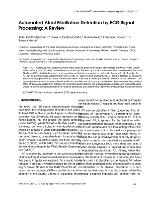Abstract
Cardiovascular diseases are the main cause of death in the world, according to the World Health Organization. Among them, ischemic heart disease is at the top, followed by a stroke. Several studies have revealed that atrial fibrillation (AF), which is the most common cardiac arrhythmia, increases up to five fold the overall risk of stroke. As AF can be asymptomatic, approximately 20% of the AF cases remain undiagnosed. AF can be detected by analyzing electrocardiography records. Many studies have been conducted to develop automatic methods for AF detection. This paper reviews some of the most relevant methods, classified into three groups: analysis of heart rate variability, analysis of the atrial activity, and hybrid methods. Their benefits and limitations are analyzed and compared, and our beliefs about where AF automatic detection research could be addressed are presented to improve its effectiveness and performance. © 2021 by Begell House, Inc.














